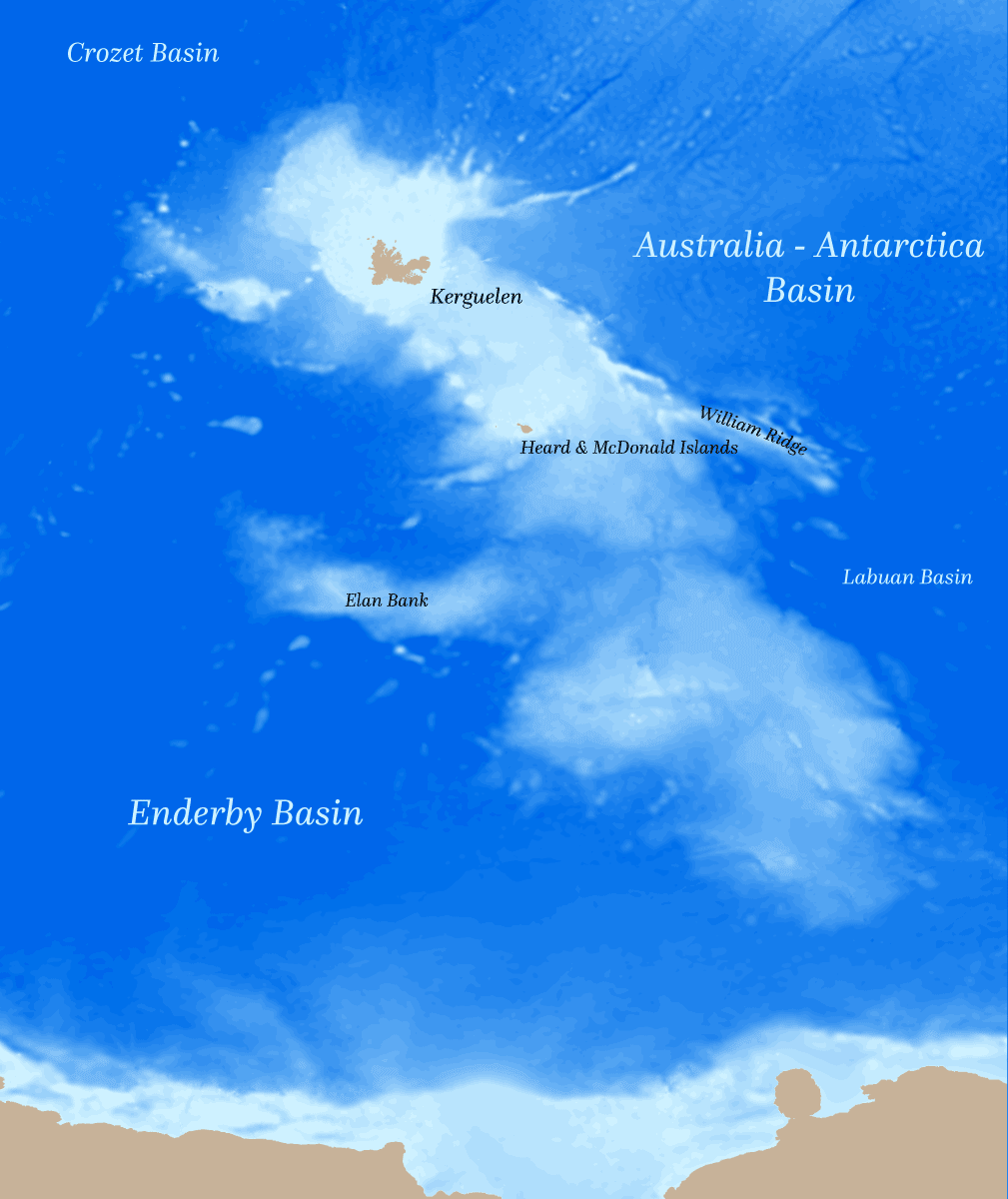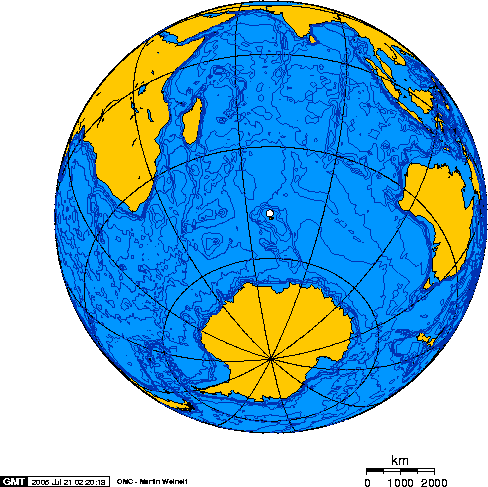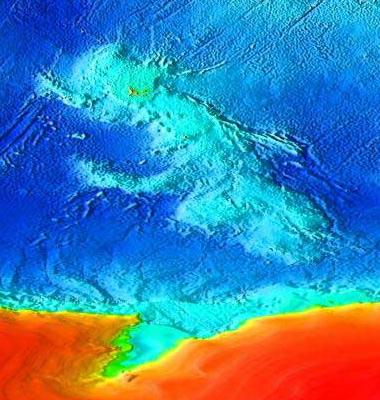Kerguelen Plateau on:
[Wikipedia]
[Google]
[Amazon]

 The Kerguelen Plateau (, ), also known as the Kerguelen–Heard Plateau, is an oceanic plateau and a
The Kerguelen Plateau (, ), also known as the Kerguelen–Heard Plateau, is an oceanic plateau and a
 Symmetrically across the Indian Ocean ridge and due west of Australia is the
Symmetrically across the Indian Ocean ridge and due west of Australia is the
 The oldest volcanism that can be attributed to the Kerguelen plume are the Bunbury Basalt (137–130.5 ) and Naturaliste Plateau (132–128 ) in southwestern Australia, and the
The oldest volcanism that can be attributed to the Kerguelen plume are the Bunbury Basalt (137–130.5 ) and Naturaliste Plateau (132–128 ) in southwestern Australia, and the

 The Kerguelen Plateau (, ), also known as the Kerguelen–Heard Plateau, is an oceanic plateau and a
The Kerguelen Plateau (, ), also known as the Kerguelen–Heard Plateau, is an oceanic plateau and a large igneous province
A large igneous province (LIP) is an extremely large accumulation of igneous rocks, including intrusive (sills, dikes) and extrusive (lava flows, tephra deposits), arising when magma travels through the crust towards the surface. The formation ...
(LIP) located on the Antarctic Plate
The Antarctic Plate is a tectonic plate containing the continent of Antarctica, the Kerguelen Plateau, and some remote islands in the Southern Ocean and other surrounding oceans. After breakup from Gondwana (the southern part of the superconti ...
, in the southern Indian Ocean
The Indian Ocean is the third-largest of the world's five oceanic divisions, covering or ~19.8% of the water on Earth's surface. It is bounded by Asia to the north, Africa to the west and Australia to the east. To the south it is bounded by t ...
. It is about to the southwest of Australia and is nearly three times the size of California
California is a state in the Western United States, located along the Pacific Coast. With nearly 39.2million residents across a total area of approximately , it is the most populous U.S. state and the 3rd largest by area. It is also the m ...
. The plateau
In geology and physical geography, a plateau (; ; ), also called a high plain or a tableland, is an area of a highland consisting of flat terrain that is raised sharply above the surrounding area on at least one side. Often one or more sides ...
extends for more than in a northwest–southeast direction and lies in deep water.
The plateau was produced by the Kerguelen hotspot
The Kerguelen hotspot is a volcanic hotspot at the Kerguelen Plateau in the Southern Indian Ocean. The Kerguelen hotspot has produced basaltic lava for about 130 million years and has also produced the Kerguelen Islands, Naturaliste Plateau, Hea ...
, starting with or following the breakup of Gondwana about 130 million years ago. A small portion of the plateau breaks sea level
Mean sea level (MSL, often shortened to sea level) is an average surface level of one or more among Earth's coastal bodies of water from which heights such as elevation may be measured. The global MSL is a type of vertical datuma standardise ...
, forming the Kerguelen Islands (a French overseas territory
Overseas France (french: France d'outre-mer) consists of 13 French-administered territories outside Europe, mostly the remains of the French colonial empire that chose to remain a part of the French state under various statuses after decoloni ...
) plus the Heard and McDonald Islands (an Australian external territory). Intermittent volcanism
Volcanism, vulcanism or volcanicity is the phenomenon of eruption of molten rock (magma) onto the surface of the Earth or a solid-surface planet or moon, where lava, pyroclastics, and volcanic gases erupt through a break in the surface called a ...
continues on the Heard and McDonald Islands.
Geographical extent
 Symmetrically across the Indian Ocean ridge and due west of Australia is the
Symmetrically across the Indian Ocean ridge and due west of Australia is the Broken Ridge
The Broken Ridge or Broken Plateau is an oceanic plateau in the south-eastern Indian Ocean. The Broken Ridge once formed a large igneous province (LIP) together with the Kerguelen Plateau. When Australia and Antarctica started to separate, the ...
underwater volcanic plateau
A volcanic plateau is a plateau produced by volcanic activity. There are two main types: lava plateaus and pyroclastic plateaus.
Lava plateau
Lava plateaus are formed by highly fluid basaltic lava during numerous successive eruptions throu ...
, which at one time was contiguous with the Kerguelen Plateau before rifting by the mid-ocean ridge
A mid-ocean ridge (MOR) is a seafloor mountain system formed by plate tectonics. It typically has a depth of about and rises about above the deepest portion of an ocean basin. This feature is where seafloor spreading takes place along a diver ...
.
To the north of Broken Ridge is the linear Ninety East Ridge
The Ninety East Ridge (also rendered as Ninetyeast Ridge, 90E Ridge or 90°E Ridge) is a mid-ocean ridge on the Indian Ocean floor named for its near-parallel strike along the 90th meridian at the center of the Eastern Hemisphere. It is approxima ...
which continues almost due north into the Bay of Bengal
The Bay of Bengal is the northeastern part of the Indian Ocean, bounded on the west and northwest by India, on the north by Bangladesh, and on the east by Myanmar and the Andaman and Nicobar Islands of India. Its southern limit is a line betwee ...
and is considered to be a hotspot track.
One of the largest igneous provinces (LIPs) in the world, the Kerguelen Plateau covers an area of and rises above the surrounding oceanic basins. Most of the plateau is less than below sea level.
Located on the Antarctic Plate
The Antarctic Plate is a tectonic plate containing the continent of Antarctica, the Kerguelen Plateau, and some remote islands in the Southern Ocean and other surrounding oceans. After breakup from Gondwana (the southern part of the superconti ...
, the Kerguelen Plateau is separated from Australia by the Southeast Indian Ridge (SEIR) and from Africa by the Southwest Indian Ridge
The Southwest Indian Ridge (SWIR) is a mid-ocean ridge located along the floors of the south-west Indian Ocean and south-east Atlantic Ocean. A divergent tectonic plate boundary separating the Somali Plate to the north from the Antarctic Plate t ...
(SWIR). These two ridges meet at the Rodriguez Triple Junction. It is separated from Antarctica by Princess Elizabeth Trough and the Cooperation Sea
Cooperation Sea, also called Commonwealth Sea (erratum) or Sodruzhestvo Sea (russian: Море Содружества), is a proposed sea name for part of the Southern Ocean, between Enderby Land (the eastern limit of which is 59°34'E) and West I ...
. The eastern margin north of the William Ridge is steep and formed during the breakup between the Kerguelen Plateau and the Broken Ridge. The southern part of the margin is separated from the Australian–Antarctic Basin by the deep Labuan Basin.
Geological history
From the initial opening of the Indian Ocean until present, the Kerguelen hotspot has produced several now widely dispersed large-scale structures. The Southern Kerguelen Plateau (SKP) formed 119–110 ; the Elan Bank 108–107 , named by Dennis E. Hayes of Lamont Doherty Earth Observatory; the Central Kerguelen Plateau (CKP) 101–100 ; theBroken Ridge
The Broken Ridge or Broken Plateau is an oceanic plateau in the south-eastern Indian Ocean. The Broken Ridge once formed a large igneous province (LIP) together with the Kerguelen Plateau. When Australia and Antarctica started to separate, the ...
(connected to the CKP before the Eocene breakup) 95–94 ; the Skiff Bank (east of the Kerguelen Islands) 69–68 ; the Northern Kerguelen Plateau (NKP) 35–34 ; the Ninety East Ridge
The Ninety East Ridge (also rendered as Ninetyeast Ridge, 90E Ridge or 90°E Ridge) is a mid-ocean ridge on the Indian Ocean floor named for its near-parallel strike along the 90th meridian at the center of the Eastern Hemisphere. It is approxima ...
formed 82–38 north to south; the Bunbury Basalt (Western Australia
Western Australia (commonly abbreviated as WA) is a state of Australia occupying the western percent of the land area of Australia excluding external territories. It is bounded by the Indian Ocean to the north and west, the Southern Ocean to th ...
) 137–130.5 ; the Naturaliste Plateau
The Naturaliste Plateau is one of several large submarine plateaus extending from Western Australia into the Indian Ocean. It is a rectilinear plateau that covers an area of 90,000 square kilometres. Its width is about east-west and north-so ...
(offshore Western Australia) formed 132–128 ; the Rajmahal Traps
The Rajmahal Traps is a volcanic igneous province in Eastern India, covering the parts of Jharkhand, West Bengal and Meghalaya. The Rajmahal Hills of Jharkhand is the type area of this province. Multiple layers of solidified lava made the Rajma ...
in Northeast India
, native_name_lang = mni
, settlement_type =
, image_skyline =
, image_alt =
, image_caption =
, motto =
, image_map = Northeast india.png
, ...
118–117 ; and finally lamprophyre
Lamprophyres () are uncommon, small-volume ultrapotassic igneous rocks primarily occurring as dikes, lopoliths, laccoliths, stocks, and small intrusions. They are alkaline silica- undersaturated mafic or ultramafic rocks with high magnesium ...
s in India and Antarctica 115–114 .
India–Australia breakup
 The oldest volcanism that can be attributed to the Kerguelen plume are the Bunbury Basalt (137–130.5 ) and Naturaliste Plateau (132–128 ) in southwestern Australia, and the
The oldest volcanism that can be attributed to the Kerguelen plume are the Bunbury Basalt (137–130.5 ) and Naturaliste Plateau (132–128 ) in southwestern Australia, and the Rajmahal Traps
The Rajmahal Traps is a volcanic igneous province in Eastern India, covering the parts of Jharkhand, West Bengal and Meghalaya. The Rajmahal Hills of Jharkhand is the type area of this province. Multiple layers of solidified lava made the Rajma ...
in eastern India (118 ). The formation of the oldest portion of the Kerguelen LIP and these continental basalts are linked to the opening of the eastern Indian Ocean. The Bunbury Basalt is not of flood basalt dimensions which suggests that the mantle underlying the newly formed Kerguelen hotspot was neither significantly hot, wet, or voluminous. In contrast, the magmatism that produced the Australia–India breakup 136–158 created the Wallaby Plateau, but no known hotspot has been linked to this event.
India–Antarctica breakup
The output from the Kerguelen hotspot peaked 120–95 , 12–70 after the India–Antarctica breakup. No ridges or hotspot tracks such as Walvis– Rio Grande, Chagos–Laccadive, Greenland–Scotland have been found in the Princess Elizabeth Trough between SKP and Antarctica or along India's conjugate eastern continental margin. The relation between the Kerguelen hotspot and these continental breakup and volcanic margins is instead similar to that between the Réunion hotspot and the Deccan Traps and the breakup between western India and theSeychelles
Seychelles (, ; ), officially the Republic of Seychelles (french: link=no, République des Seychelles; Creole: ''La Repiblik Sesel''), is an archipelagic state consisting of 115 islands in the Indian Ocean. Its capital and largest city, ...
.
The peak output of the Kerguelen hotspot coincides with one or several microcontinent formations, such as the Elan Bank. Since the Indian Ocean began to open about 130 , the Kerguelen hotspot has moved 3–10° southward and, consequently, the spreading ridge between India and Antarctica has jumped northward one or several times. Parts of the Kerguelen Plateau, the Elan Bank and the SKP, were originally attached to India and are composed of continental lithosphere. One or several ridge jumps transformed the Elan Bank into a microcontinent and dispersed continental fragments in the SKP, and these structures were eventually left behind as India moved northward. The ridge jump that made the Elan Bank a microcontinent occurred after 124 . The development of the Southern Kerguelen Plateau 118–119 contributed to the oceanic anoxic event 1.
Around 83.5 sea floor spreading between India and Antarctica was asymmetric in the Kerguelen Plateau region with two-thirds of the sea floor created being added to the Antarctic Plate. A ridge jump eventually transferred parts of the Kerguelen Plateau from the Indian Plate to the Antarctic Plate.
Cenozoic volcanism
The Kerguelen hotspot produced the long Ninety East Ridge 82–38 , and geochemical evidence suggests that this occurred at or near a spreading ridge. The lack of a conjugate structure on the Antarctic Plate, however, makes it unlikely that the hotspot was located at a spreading ridge during this long period. As the Antarctic Plate then moved over the Kerguelen hotspot the NKP formed over relatively old oceanic crust. Flood basalts in the Kerguelen archipelago formed 30–24 and less voluminous and more recent volcanism occurred until 1 . During the last 21 volcanic structures have formed on the CKP, including Heard Island, and both Heard and McDonald Islands have had recent eruptions. 65 , the CKP–Broken Ridge LIP was located near the Kerguelen plume and the plate boundaries of the Indian Ocean. The LIP was the product of 25 of relatively high magmatic activity followed by a 40 period of lower activity.Microcontinent
described tilted basement blocks near the Kerguelen Archipelago and were the first to identify the Kerguelen Plateau as of continental origin, in contrast to other LIPs. The presence of soil layers in the basalt which included charcoal and conglomerate fragments ofgneiss
Gneiss ( ) is a common and widely distributed type of metamorphic rock. It is formed by high-temperature and high-pressure metamorphic processes acting on formations composed of igneous or sedimentary rocks. Gneiss forms at higher temperatures a ...
indicate that much of the plateau was above sea level as what is termed a microcontinent
Continental crustal fragments, partly synonymous with microcontinents, are pieces of continents that have broken off from main continental masses to form distinct islands that are often several hundred kilometers from their place of origin.
Caus ...
for three periods between 100 million years ago and 20 million years ago (the charcoal was made by wildfire
A wildfire, forest fire, bushfire, wildland fire or rural fire is an unplanned, uncontrolled and unpredictable fire in an area of combustible vegetation. Depending on the type of vegetation present, a wildfire may be more specifically identi ...
s started by lightning or lava flows). Large parts of the now-submarine Southern Kerguelen Plateaus (SKP) and Central Kerguelen Plateaus (CKP) were subaerial during the formation of the LIP. The SKP probably formed an island of with major peaks reaching above sea level.
The Kerguelen Microcontinent may have been covered by dense conifer forest in the mid-Cretaceous
The Cretaceous ( ) is a geological period that lasted from about 145 to 66 million years ago (Mya). It is the third and final period of the Mesozoic Era, as well as the longest. At around 79 million years, it is the longest geological period of ...
. The plateau had been proposed as forming a land bridge
In biogeography, a land bridge is an isthmus or wider land connection between otherwise separate areas, over which animals and plants are able to cross and colonize new lands. A land bridge can be created by marine regression, in which sea leve ...
between India and Antarctica during the Late Cretaceous, though this is now considered unsupported, with the plateau situated considerable distance from the nearest continents.
It finally sank 20 million years ago and is now below sea level.
Biodiversity
During the austral summer there is a high density of migratory whales including sperm, minke, and humpback whales along the southern end of the Kerguelen Plateau and the northern part of the adjacent Princess Elizabeth Trough. These whales choose this location for foraging because the Southern Front of the Antarctic Circumpolar Current is steered off by the Plateau—resulting in a poleward extent for the Southern Front only found near the Kerguelen Plateau. This brings shoaled, nutrient-rich Upper Circumpolar Deep Water to the surface which brings macronutrients to the surface. Ice is additionally advected north along the eastern side of the plateau.See also
* * * *References
Notes
Sources
* * * * * * * * * * * {{DEFAULTSORT:Keguelen Plateau Large igneous provinces Plateaus of the Indian Ocean Historical continents Landforms of the Kerguelen Islands Continental fragments Cretaceous volcanism Volcanism of the Indian Ocean Landforms of Heard Island and McDonald Islands